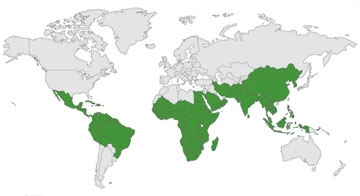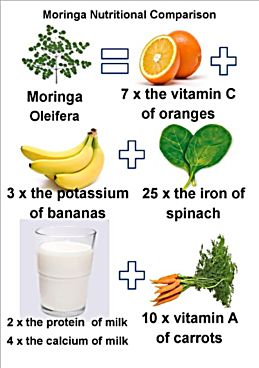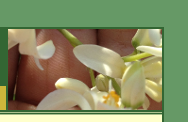

There are many benefits of the moringa tree, but the health benefits are the most important. Research has shown that various parts of the moringa tree can be effective in a significant number of health concerns. Here’s a quick look at a few of them:
Moringa is rich in Vitamin A. It contains four times more Vitamin A or beta-carotene than carrots. Hence, it is a weapon against blindness.
It is also a rich source of Vitamin C many times more than oranges.
Normally milk is said to be a rich source of calcium but the amount of calcium present in moringa leaves is 4 times higher than in milk.
The moringa leaves are said to contain two times the protein present in milk.
Bananas are a rich source of potassium. But moringa leaves contain 3 times more potassium than bananas.
Along with potassium, zinc is also found in large quantities in moringa.
If moringa leaves were to be eaten by one and all, the world will be free of anemia as it contains twenty five times more iron than spinach.
With all the junk food eaten these days, many people face problems of high cholesterol. Moringa helps in balancing the cholesterol levels in the body.
Essential Amino acids are also found in moringa.
Moringa is also said to balance sugar levels, hence it is helpful in the fight against diabetes.
The body's natural defense mechanism increases with the consumption of moringa in the daily diet pattern. Since it is an immunity-stimulant, it is prescribed for AIDS afflicted patients.
Moringa leaves can be consumed to stimulate metabolism.
It is also said to have digestive powers.
It is a nutrition booster and is known to promote a feeling of well-being in people.
If you are looking for non-sugar based energy, then moringa leaves is the answer. Thus, it will also help in the weight loss process.
The cell structure of the body is stimulated by the moringa leaves.
It is especially useful for lactating mothers. The consumption of moringa has shown dramatic increase in the quantity of breast milk.
It is also famous for its anti-bacterial properties.
The paste of the moringa leaves is said to beautify the skin and is hence applied by women regularly.
It protects the liver and kidneys.
It can also be used as a water purifier.
Moringa contains more than 90 nutrients and 46 types of antioxidants. With all the health benefits of moringa, it can easily be termed as the most nutritious plant on the face of the earth. There are no side-effects of moringa tree leaves which have been proved till date. At the same time it can be consumed by small children and adults alike. Therefore, many people have started using it in porridge, pastas, breads, etc., to reap the everlasting health benefits of the extraordinary 'moringa'.
According to Dr. Monica G. Marcu, researcher and clinical pharmacologist, Moringa is unique because, even in small amounts, it can supply daily a wide gamut of vital nutrients with few calories.
Vitamin and mineral content are just the beginning. Moringa has 18 amino acids, including the eight essentials – the ones your body can not survive without but can not manufacture on its own; they must be supplied through diet.
Moringa is as good a source of roughage as carrots but has quadruple the beta carotene content. It also has plenty of omega-3 oils and chlorophyll, plus 45 compounds with antioxidant properties and 36 with anti-inflammatory properties.
To the average Joe, Moringa is a simple way to manage many health problems. It can help reduce cholesterol and triglycerides, control blood sugar, and offer anti-aging and anti-inflammatory substances, many of which have anti-cancer properties.
Moringa contains more than 90 nutrients and 46 types of antioxidants. With all the health benefits of moringa, it can easily be termed as the most nutritious plant on the face of the earth. There are no side-effects of moringa tree leaves which have been proved till date. At the same time it can be consumed by small children and adults alike. Therefore, many people have started using it in porridge, pastas, breads, etc., to reap the everlasting health benefits of the extraordinary 'moringa'.
According to Dr. Monica G. Marcu, researcher and clinical pharmacologist, Moringa is unique because, even in small amounts, it can supply daily a wide gamut of vital nutrients with few calories.
Vitamin and mineral content are just the beginning. Moringa has 18 amino acids, including the eight essentials – the ones your body can not survive without but can not manufacture on its own; they must be supplied through diet.
Moringa is as good a source of roughage as carrots but has quadruple the beta carotene content. It also has plenty of omega-3 oils and chlorophyll, plus 45 compounds with antioxidant properties and 36 with anti-inflammatory properties.
To the average Joe, Moringa is a simple way to manage many health problems. It can help reduce cholesterol and triglycerides, control blood sugar, and offer anti-aging and anti-inflammatory substances, many of which have anti-cancer properties.
Moringa leaves could practically wipe out malnutrition in the Peten Jungle And tropical regions of the world.
Experts agree that the long-term solution to malnutrition is the use of foods rich in the essential nutrients often lacking in people's diets. Modern scientific research is proving that Moringa leaves are one of the richest sources of such nutrients. Even small amounts of the leaves could protect thousands of people from suffering and death.
People in several countries have found that Moringa leaves are quite acceptable to taste, especially when added to common foods such as rice and corn.
Imagine a tree in your backyard that will meet all your nutritional needs, take care of you medicinally, and purify your water for you. This tree actually exists. For centuries, the natives of northern India and many parts of Africa have known of the many benefits ofMoringa oleifera. Its uses are as unique as the names it is known by, such as clarifier tree, horseradish tree and drumstick tree (referring to the large drumstick shaped pods) and in East Africa it is called "mother's best friend”. Virtually every part of the tree can be used. Native only to the foothills of the Himalayas, it is now widely cultivated in Africa, Central and South America, Sri Lanka, India, Malaysia and the Philippines. This tree, though little known in the Western world, is nutritional dynamite. There are literally hundreds of uses for this tree.
The immaturepodsare the most valued and widely used of all the tree parts. The pods are extremely nutritious, containing all the essential amino acids along with many vitamins and other nutrients. The immature pod can be eaten raw or prepared like green peas or green beans, while the mature pods are usually fried and possess a peanut-like flavor. The pods also yield 38 - 40% of non-drying, edible oil known as Ben Oil. This oil is clear, sweet and odorless, and never becomes rancid. Overall, its nutritional value most closely resembles olive oil. The thickenedrootis used as a substitute for horseradish although this is now discouraged as it contains alkaloids, especially moriginine, and a bacteriocide, spirochin, both of which can prove fatal following ingestion. Theleavesare eaten as greens, in salads, in vegetable curries, as pickles and for seasoning. They can be pounded up and used for scrubbing utensils and for cleaning walls. Leaves and young branches are relished by livestock. TheBarkcan be used for tanning and also yields a coarse fiber. Theflowers, which must be cooked, are eaten either mixed with other foods or fried in batter and have been shown to be rich in potassium and calcium.
In developing tropical countries, Moringa trees have been used to combat malnutrition, especially among infants and nursing mothers. Three non-governmental organizations in particular - Trees for Life, Church World Service and Educational Concerns for Hunger Organization - advocate Moringa as“natural nutrition for the tropics.” Leaves can be eaten fresh, cooked, or stored as dried powder for many months without refrigeration, and without loss of nutritional value. Moringa is especially promising as a food source in the tropics because the tree is in full leaf at the end of the dry season when other foods are typically scarce. Analyses of the leaf composition have revealed them to have significant quantities of vitamins A, B and C, calcium, iron and protein. According to Optima of Africa, Ltd., a group that has been working with the tree in Tanzania, "25 grams daily of Moringa Leaf Powder will give a child" the following recommended daily allowances:
Protein 42%, Calcium 125%, Magnesium 61%, Potassium 41%, Iron 71%, Vitamin A 272%, and Vitamin C 22%. These numbers are particularly astounding; considering this nutrition is available when other food sources may be scarce.
Scientific research confirms that these humble leaves are a powerhouse of nutritional value. Gram for gram, Moringa leaves contain: SEVEN times the vitamin C in oranges, FOUR times the Calcium in milk, FOUR times the vitamin A in carrots, TWO times the protein in milk and THREE times the Potassium in bananas.
The Moringa tree has great use medicinally both as preventative and treatment. Much of the evidence is anecdotal as there has been little actual scientific research done to support these claims. India's ancient tradition of ayurveda says the leaves of the Moringa tree prevent 300 diseases. One area in which there has been significant scientific research is the reported antibiotic activity of this tree.
This is clearly the area in which the preponderance of evidence - both classical scientific and anecdotal evidence - is overwhelming. The scientific evidence has now been available for over 50 years, although much of it is completely unknown to western scientists. In the late 1940’s and early 1950’s a team from India identified a compound they called pterygospermin. This group was also able to demonstrate its mode of antimicrobial action in the mid 1950’s. Field reports and ecological studies form part of a rich traditional medicine history claiming efficacy of leaf, seed, root, bark, and flowers against a variety of dermal and internal infections. In 1964 other active compounds were isolated and tested in-vitro, and these studies, along with observational studies provide a very plausible mechanism of action for the centuries of claims of efficacy. Unfortunately, because many of the reports of antibiotic efficacy in humans are not supported by placebo controlled, randomized clinical trials, Western medical prejudice leaves the Western world ignorant of Moringa’s antibiotic properties.
Another area of folklore which research supports is in cancer treatment. Moringa species have long been recognized by folk medicine practitioners as having value in the treatment of tumors. Studies examined certain compounds for their cancer preventive potential. Recently two of these compounds were shown to be potent inhibitors of activation of lymphoblastoid (Burkitt’s lymphoma) cells. One of these compounds also inhibited tumors in mice bred to be prone to tumors. In another study, Bharali and colleagues examined skin tumor prevention following ingestion of drumstick (Moringa seedpod) extracts. In this mouse model, which included appropriate positive and negative controls, a dramatic reduction in skin tumors was demonstrated. More rigorous study is required in order to achieve a level of proof required for full medical endorsement of Moringa as, in this case, a cancer preventative plant.
After the oil is extracted from the pods, the seed-cake remaining contains the active components for removing turbidity (solid particles) from water. Because bacteria adhere to the solids, this seed-cake also effectively removes bacteria. At the Thyolo Water Treatment Works in Malawi, Africa, two researchers from the University of Leicester, England, have worked on substituting moringa seeds for alum to remove solids in water for drinking. Not only were the tests successful in removing as much solid material as alum, but the seeds used were "purchased from enthusiastic villagers in Nsanje Region in Malawi" (Folkard and Sutherland, 1996. Not only is Moringa oleifera as effective as aluminum sulphate (alum) in removing suspended solids from turbid water, it has a major advantage. Because it can be produced locally, "using Moringa rather than alum would save foreign exchange and generate farm and employment income." The potential for Moringa to create a new market for a community is there, and studies and projects are taking place examining this potential. Use of this natural substance would also remove a source of aluminum contamination.
This tree is truly a “miracle” tree offering hope; nutritionally, medicinally and economically to devastatingly poor 3rdworld countries. It has just recently begun being used as a supplement in a juice form and in powdered leaf tablets.
Sources:
Ramachandran,C., Peter,K.V. and Gopalakrishnan,P.K., 1980, Drumstick (Moringa oleifera): A multipurpose Indian Vegetable. Economic Botany, 34 (3) pp276-283.
http://peacecorps.mtu.edu/resources/studentprojects/moringa.htm
http://www.tfljournal.org/article.php/20051201124931586
Meitzner and Price (Amaranth to Zai Holes: Ideas for Growing Food Under Difficult Conditions,ECHO, 1996),
http://www.lboro.ac.uk/departments/cv/wedc/papers/20/sessioni/sutherla.pdf
Learn more:http://www.naturalnews.com/022272.html#ixzz1taPIfj74
